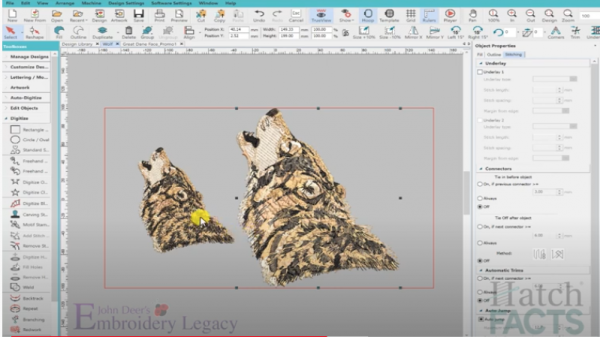

In-the-Hoop Projects: Zipper Insertions.Digitizer’s Dream Course Overview & Level 1.

It is recommended to change colors using the Resequence Docker color blocks. This method is best used when you will make minor changes to the design.ħ. So you can see how you could lose "details" in the design and/or the design can get too dense".Ħ. The current stitches stay and only get closer together or further apart. Remember, it will not "add stitches or reduce stitches" based on the size, like an object file will. Resizing limitations: It is recommended that you only resize up or down by 10% when using a file with stitches only. If you do need to edit stitch points, then do this last, after all the other changes have been made, such as resize, change colors, etc.ĥ. So it is really important to ensure you have saved your file and save often.Ĥ. While you can reshape by moving the single needle points with "stitches only", it is time-consuming and uses a lot of computer resources. Reshape is one area that will have limitations. You will not be able to edit the design as much when opening as stitches only. Only if this does not work, will I use the "Leave stitches as individual stitches". I will generally first open designs with the usual "Convert stitches into object shapes" as this has more editing power. This will then change to become the default.Ģ. So when you go to open your next design, unless you wish to do the same, remember to follow those steps and open them as "Convert stitches into object shapes". When you open a file to leave as individual stitches, this becomes the default when opening future designs. Other facts to keep in mind when you use this method:ġ. Then after you are finished working with this design you can save (export) to "dog1_stitches.PES". When you do this, it will retain your edits, color changes, etc. TOP TIP: Save the file as "dog1_stitches. if you then have problems or do not like what you have done, you can always revert back to the original file. Save (export) the file as "dog1_stitches.PES" before you start working with the design. DO NOT save over your original file.Įxample: Original file name is "dog1.PES". We recommend that you immediately save (export) the file, using a name that indicates it as "stitches". The design will open as stitch points only. You will see the dialog box "Options." as shown above.ģ) Click to select "Leave stitches as individual stitches" In this case, Hatch Embroidery allows you to open the design as "Stitches only".ġ) When you open the design > find your stitch file type in the drop-down list But, when you have designs where the outline of the object cannot be determined, it can give you either or both of the problems stated above. Normally, you open files to recognize as outlines of the object, because this will give you more editing power in Hatch Embroidery. When you see this happen, Hatch Embroidery offers a way to work around this! Solution: Open as "Stitches only", not "Recognized outlines" Each time it is converted, the quality could have degraded or some of the stitch types converted differently. Some stitch files may actually be converted through several formats before it finally gets to you in the format you have. This will depend on how the original design was digitized and then saved. Problem 3: Sometimes, you have a stitch file and it does not open at all. Problem 2: Sometimes, when you resize a stitch file, some of the stitches may be lost or some of the special stitch effects are lost.

Problem 1: Sometimes, when you open a stitch file, some of the stitches may have been lost. What to do when stitch files do not resize correctly


 0 kommentar(er)
0 kommentar(er)
